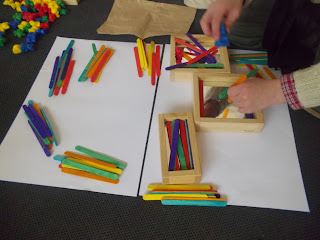We are always so fortunate with the weather! It was a
beautiful, sunny morning today once again. We were also very fortunate to have
so many family helpers come along – thank you to the mums Jane, Sarah and Michelle,
and to grandmother Madeleine.
We have been discussing the difference between native and indigenous plants, and weeds in our learning community, and the children hypothesized which plants they believe are native or introduced and why. They identified size and shape of the leaves as indicators that they may be weeds.
We also found a fascinating piece of rock that the children suggested did not come from the area, and may be volcanic because of the tiny holes covering it. It is wonderful to see them explore the environment with such gusto and curiosity.
We are really noticing the relationships that the children
are forming with the special space that we keep visiting. We are noticing it in
their interactions, their conversations and their confidence. There is a sense
of belonging emerging, which is a beautiful thing.
Once again, lots of children were concerned about the amount
of rubbish and they collected much of it to take back to rubbish bins at
school. Children also continued to clean the lovely wooden seat of bird poo,
but they have exclaimed that the birds keep pooing on it, so some creative
strategies may need to be implemented. They suggested placing something that
smells good to birds further away so they would hang out and poo over there
instead. Worms smell good to birds, they said. Another idea was to place
something that smells terrible for birds near the seat to deter them, like
‘bird spray’. We may need to invent that.
Other children spent a lot of time on the bank. There,
children hypothesised as to why there are cracks in the ground. “Perhaps because
people keep stamping on the ground”; “perhaps because the water comes up here
sometimes and makes it crack”; “perhaps it’s from the earthquake ages ago”;
“perhaps it’s from people making cracks in the ground”. Then they discovered
lots of metal hooks stuck in the ground and the hypotheses started all over
again! Other children sat on the bank with rods (sticks) and fished for ages,
catching gummy sharks, eels, whales and all sorts of other impressive sea
creatures. Their imaginative play was rather convincing.
Other children made cubbies in the trees for themselves and
birds, placing sticks for birds to perch on and flowers to attract them.
Other children were interested in the dogs playing nearby
and that instigated a discussion about dog safety.
Other children were fascinated by the variation in plants in
the area. We collected many specimens to
bring back to our learning community.
We have been discussing the difference between native and indigenous plants, and weeds in our learning community, and the children hypothesized which plants they believe are native or introduced and why. They identified size and shape of the leaves as indicators that they may be weeds.
Many children were particularly drawn to the details that they found on some of the plant leaves. They hypothesized that the plants may be sick, suffering from a lack of water or attacked by insects.





























































